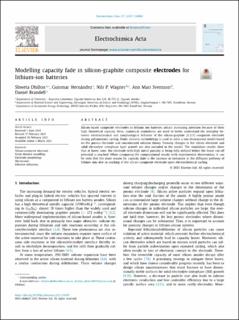| dc.contributor.author | Dhillon, Shweta | |
| dc.contributor.author | Hernández, Guiomar | |
| dc.contributor.author | Wagner, Nils Peter | |
| dc.contributor.author | Svensson, Ann Mari | |
| dc.contributor.author | Brandell, Daniel | |
| dc.date.accessioned | 2022-08-12T07:07:40Z | |
| dc.date.available | 2022-08-12T07:07:40Z | |
| dc.date.created | 2021-08-19T12:57:32Z | |
| dc.date.issued | 2021 | |
| dc.identifier.citation | Electrochimica Acta. 2021, 377 1-9. | en_US |
| dc.identifier.issn | 0013-4686 | |
| dc.identifier.uri | https://hdl.handle.net/11250/3011510 | |
| dc.description.abstract | Silicon-based composite electrodes in lithium ion batteries attract increasing attention because of their high theoretical capacity. Here, numerical simulations are used to better understand the interplay between electrochemical and morphological behavior of the silicon-graphite (1:2.7) composite electrode during galvanostatic cycling. Finite element methodology is used to solve a one-dimensional model based on the porous electrode and concentrated solution theory. Porosity changes in the silicon electrode and solid electrolyte interphase layer growth are also included in the model. The simulation results show that at lower rates, the electrode with high initial porosity is being fully utilized before the lower cut-off potential is reached. When comparing the computational results with experimental observations, it can be seen that the main reason for capacity fade is the increase in tortuosity in the diffusion pathway of lithium ions due to cracking of the silicon composite electrode upon electrochemical cycling. | en_US |
| dc.language.iso | eng | en_US |
| dc.publisher | Elsevier | en_US |
| dc.rights | Navngivelse 4.0 Internasjonal | * |
| dc.rights.uri | http://creativecommons.org/licenses/by/4.0/deed.no | * |
| dc.subject | Effective diffusivity | en_US |
| dc.subject | Microcracks | en_US |
| dc.subject | Electrode morphology | en_US |
| dc.subject | Finite element modelling | en_US |
| dc.subject | Silicon-composite electrode | en_US |
| dc.title | Modelling capacity fade in silicon-graphite composite electrodes for lithium-ion batteries | en_US |
| dc.type | Peer reviewed | en_US |
| dc.type | Journal article | en_US |
| dc.description.version | publishedVersion | en_US |
| dc.rights.holder | © 2021 The Authors. Published by Elsevier Ltd | en_US |
| dc.source.pagenumber | 1-9 | en_US |
| dc.source.volume | 377 | en_US |
| dc.source.journal | Electrochimica Acta | en_US |
| dc.identifier.doi | 10.1016/j.electacta.2021.138067 | |
| dc.identifier.cristin | 1927293 | |
| dc.relation.project | Norges forskningsråd: 255195 | en_US |
| dc.relation.project | Norges forskningsråd: 257653 | en_US |
| dc.source.articlenumber | 138067 | en_US |
| cristin.ispublished | true | |
| cristin.fulltext | original | |
| cristin.qualitycode | 2 | |

